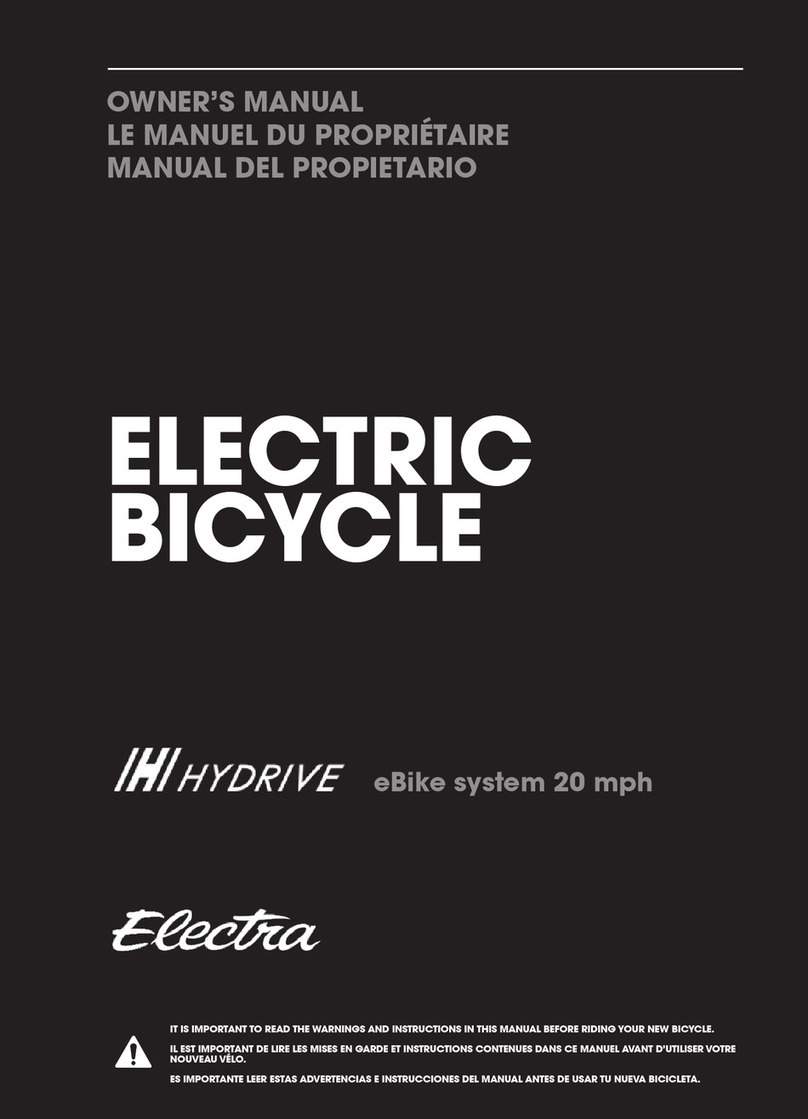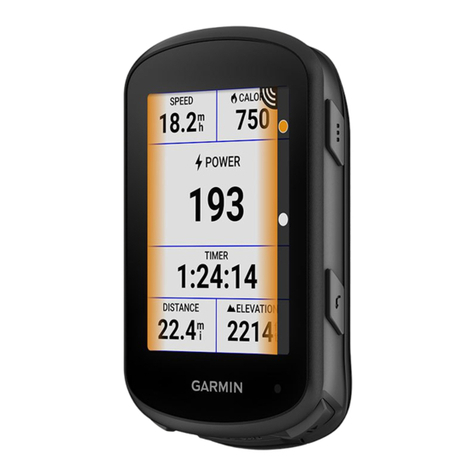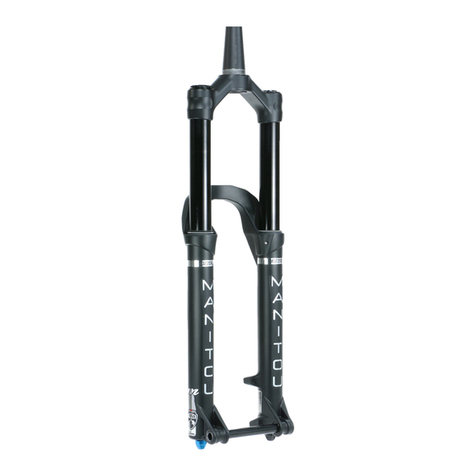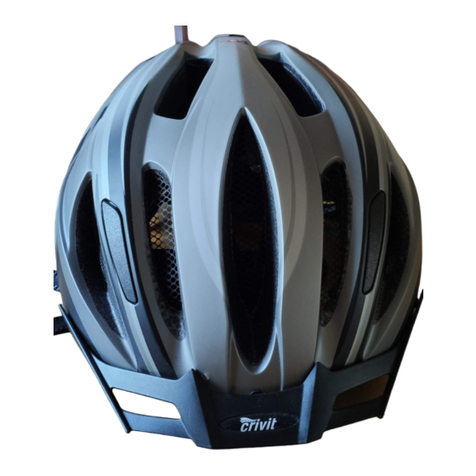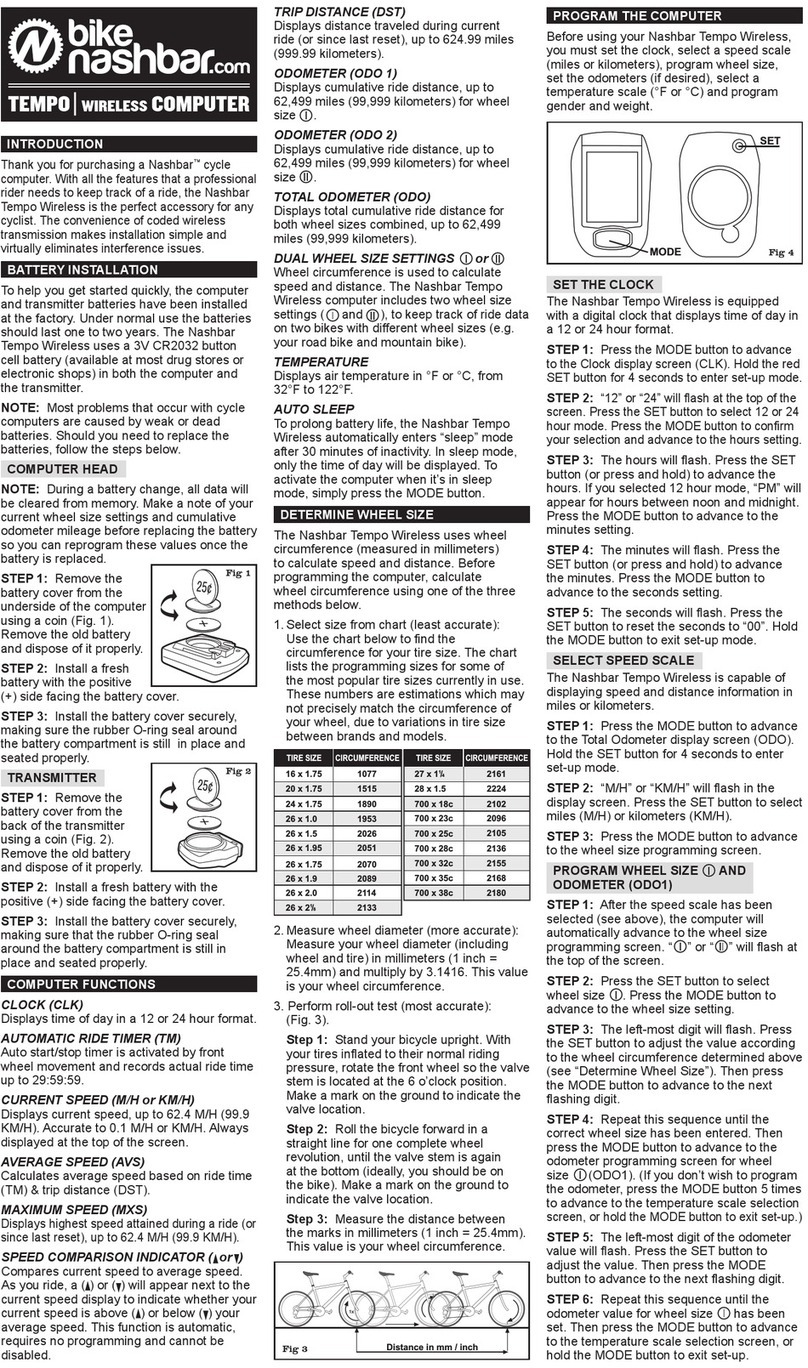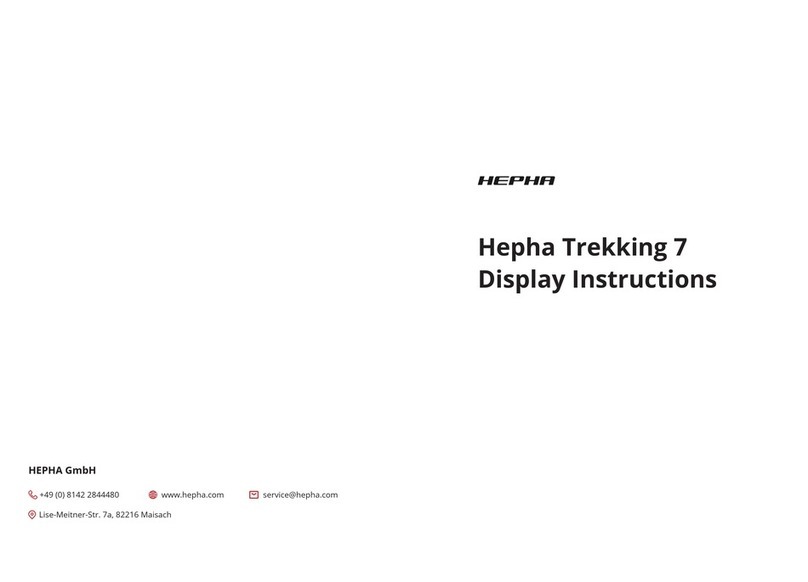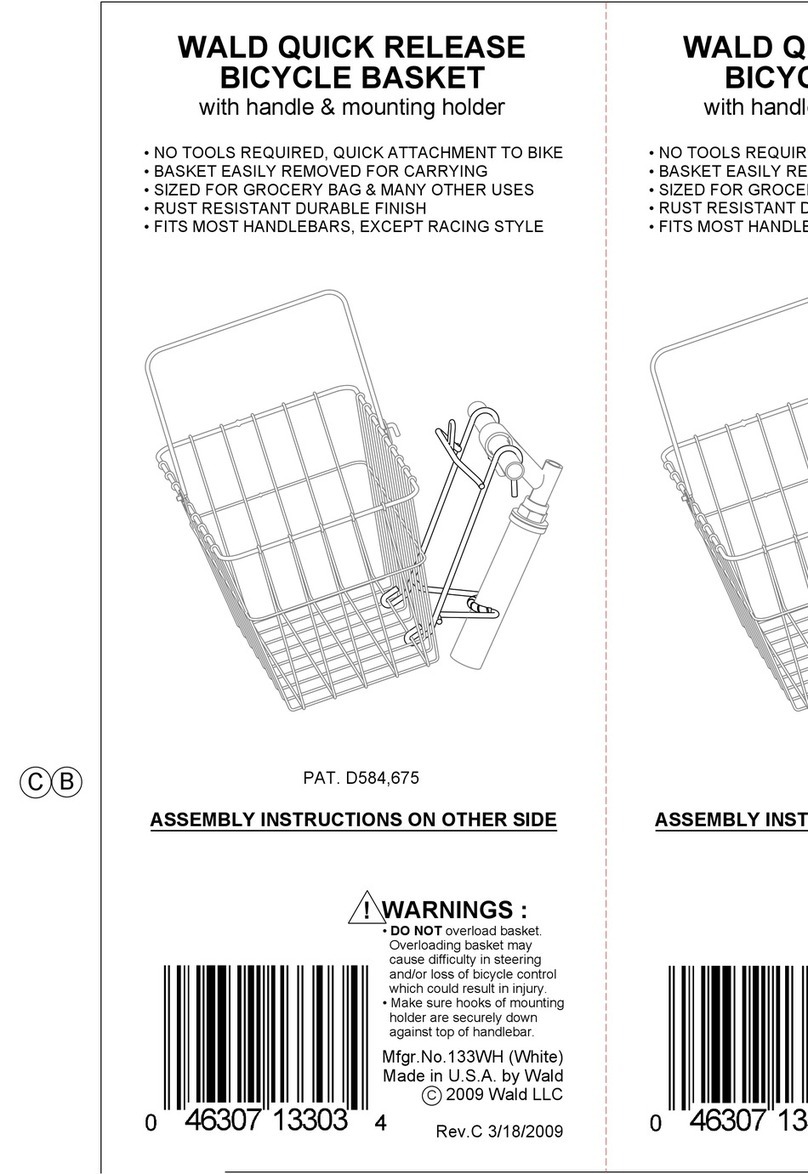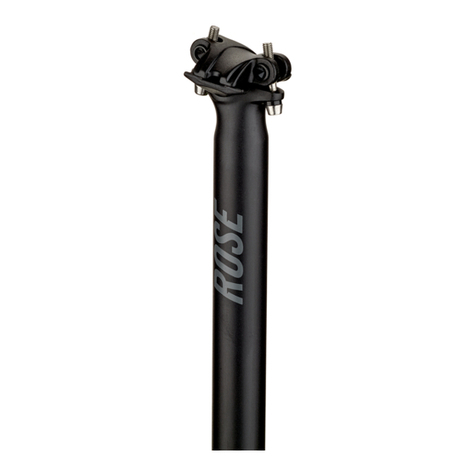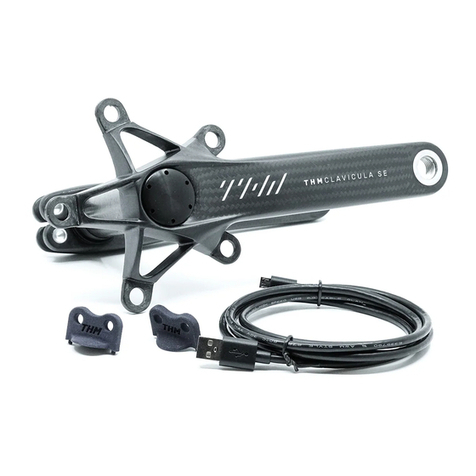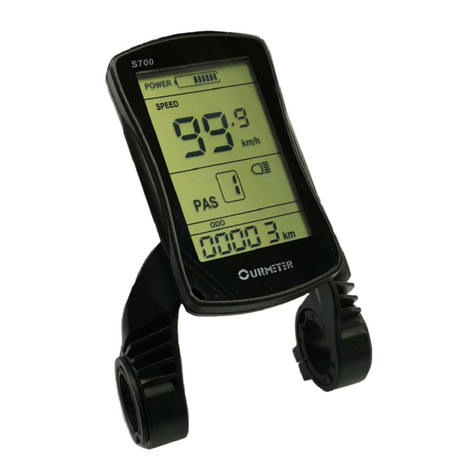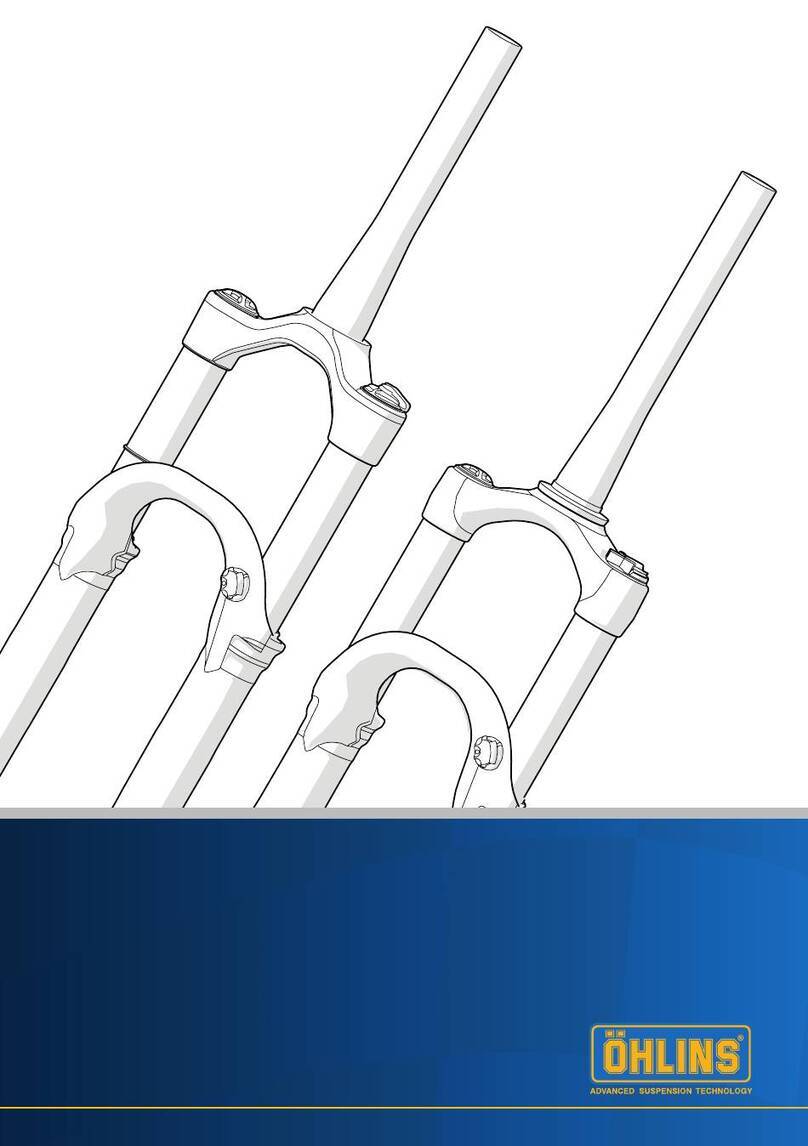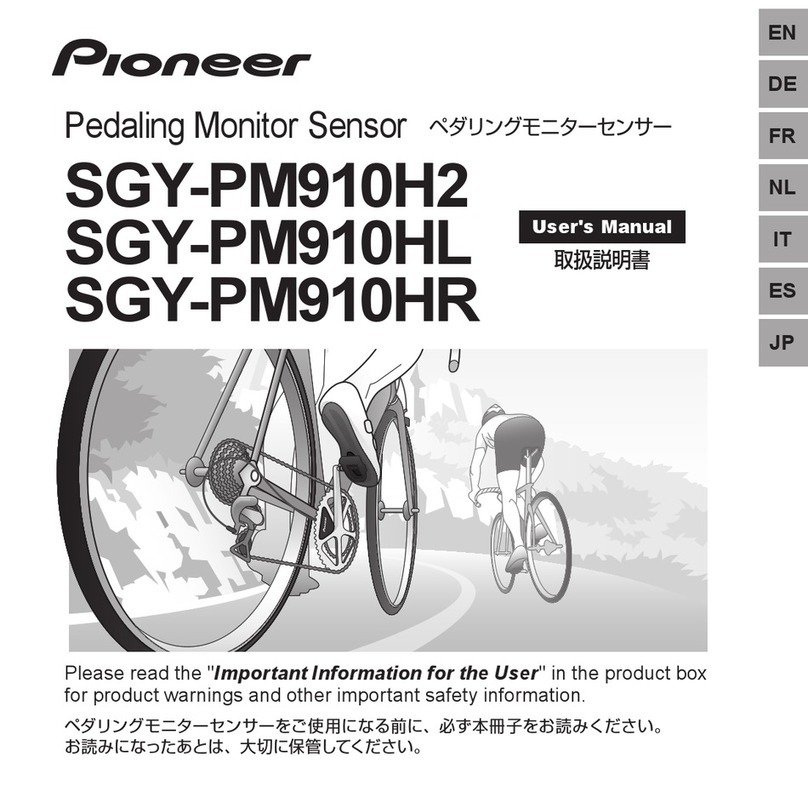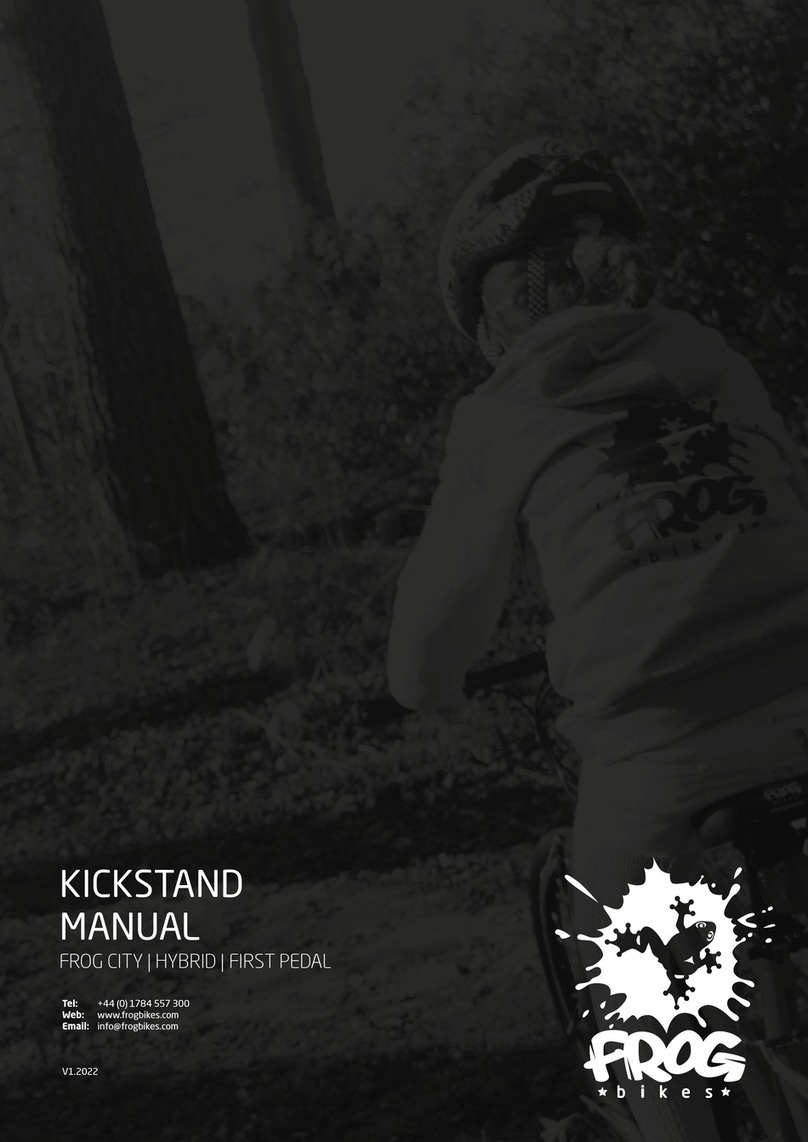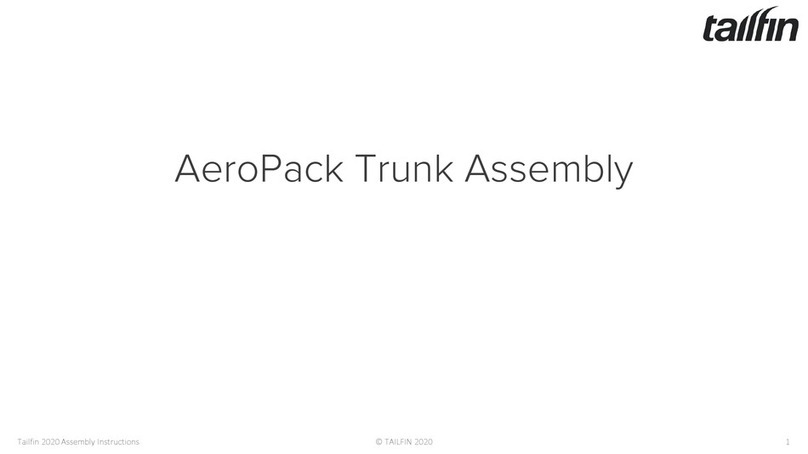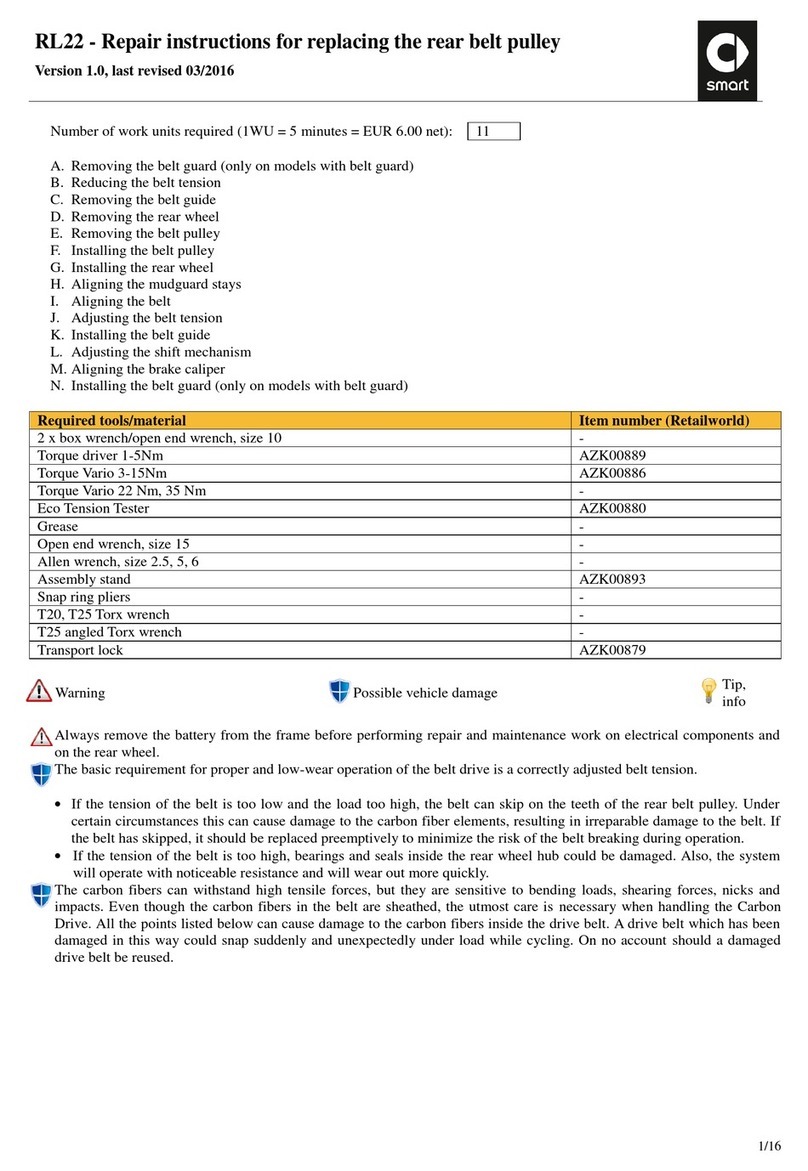Electra BICYCLE HELMET User manual

BICYCLE HELMET MANUAL
ENGLISH
DEUTSCH
ESPAÑOL
FRANÇAIS
ITALIANO
POLSKI

1
CONGRATULATIONS
for choosing an Electra bicycle helmet.This helmet is constructed to meet the highest
standards for performance and safety. With correct adjustment, care, and maintenance,
this helmet will help you ride safely.
HERZLICHEN GLÜCKWUNSCH
zu Ihrer Wahl eines Electra Fahrradhelms. Dieser Helm erfüllt die höchsten Ansprüche in
Bezug auf Leistung und Sicherheit. Bei korrekter Einstellung, Pege und Wartung sorgt
dieser Helm dafür,dass Sie sicher unterwegs sind.
TE FELICITAMOS
por haber adquirido un casco para bicicleta Electra. Este casco ha sido fabricado de
acuerdo a los más altos estándares de rendimiento y seguridad. Con el ajuste, cuidado y
mantenimiento adecuados, este casco te permitirá practicar una conducción segura.
FÉLICITATIONS
pour votre acquisition d’un casque de vélo Electra. Ce casque est construit an de
respecter les normes les plus strictes en matière de performances et de sécurité.Avec
un réglage, des soins et un entretien corrects, ce casque contribuera à la sécurité de vos
sorties à vélo.
CONGRATULAZIONI
per aver scelto il casco da bicicletta Electra. Questo casco è realizzato per soddisfare
gli standard più elevati per prestazioni e sicurezza. Con la regolazione, cura e
manutenzione corrette, questo casco vi consentirà di pedalare in sicurezza.
GRATULUJEMY
wyboru kasku rowerowego Electra. Ten kask został zaprojektowany z myślą o spełnieniu
najwyższych standardów w zakresie wydajności i bezpieczeństwa. Prawidłowa obsługa,
regulacja i konserwacja kasku rowerowego pozwolą na bezpieczną jazdę na rowerze.

2
Read this manual before riding with your new helmet!
Correct adjustment and use of this helmet is critical to safety. Parents should explain the
information in this manual to their children or anyone who is not able to understand.
If you do not understand information in this manual, consult your dealer. If you have a
question or problem that your dealer cannot handle, contact us at our
address, telephone, or web site:
This manual meets the requirements for the following standards:
• U.S. Consumer Product Safety Commission 16 CFR Part 1203
• ASTM F 1447-06
• EN 1078
• AS/NZS 2063:2008
Tested by:
Taicang ACT Sporting Goods Testing Co.,Ltd
No.35 Zhenghe Road, Ludu Town,
Taicang City, Suzhou, Jiangsu Province, China 215412
Ph: 86.512.53230300
Notied Body:
Telecation Edisonstraat 12A, 6902 PK Zevenaar, Netherlands
(NB#0560) Al Gen. JÓzefra Hallera 126 80-416
Gdan’sk, Poland
Polski Rejestr Statków S.A. 80-416 Gdańsk, Poland
USA
Electra Bicycle Company
Attn: Customer Service
1010 S. Coast Highway 101, Ste. 101
Encinitas, CA 92024
800-261-1644
electrabike.com
Australia
Trek Bicycle Corporation
Attn: Customer Service
(Australia) Pty Ltd
PO Box 1747
Fyshwick, ACT 2609
electrabike.com
EUROPE
Bikeurope BV
Attn: Customer Service
Ceintuurbaan 2-20C
3847 LG Harderwijk
The Netherlands
+31 (0)88 4500 699
electrabike.com

3
About Your Helmet
A helmet can provide important protection if tted and worn correctly.
Important safety information:
A helmet must be correctly worn and maintained to provide
protection. Carefully read and follow these instructions. Incorrect use
or maintenance of your helmet could lead to serious injury or death.
Ride safely. No helmet can protect the wearer against all possible impacts.A
severe impact, sharp object, improper use, or incorrect adjustment could cause
conditions beyond the protection of the helmet.
Check the adjustment before every ride. To be effective, a helmet must
t and be worn correctly. The helmet is designed to be retained by a strap
under the lower jaw. To check for correct t, place helmet on head and make
any adjustments indicated. Securely fasten retention system. Grasp the helmet
and try to rotate it to the front and rear. A correctly tted helmet should be
comfortable and should not move forward to obscure vision or rearward to
expose the forehead. If you cannot correctly adjust your helmet, consult your
dealer.
Avoid high heat. Do not expose your helmet to heat, such as inside a car on a
sunny day. Excessive heat can damage the liner or shell, or make them separate.
Avoid chemicals. The helmet may be damaged and rendered ineffective by
petroleum and petroleum products, cleaning agents, paints, adhesives and the
like, without the damage being visible to the user. Also, some insect repellants
can damage the helmet.
Replace an old helmet or helmet with damage. The helmet is designed
to absorb shock by partial destruction of the shell and liner. This damage may
not be visible. Therefore, if subjected to a severe blow, the helmet should
be destroyed and replaced even if it appears undamaged. The helmet has a
limited lifespan in use and should be replaced when it shows obvious signs of
wear. Helmet parts lose strength over time, so even if the helmet has not been
impacted or damaged, replace it after three years.
WARNING

Helmets vary in both design and protection. This helmet is designed
for use in recreational bicycle riding; it does not offer the same protection as a
helmet designed for use in rock climbing, roller-skating, or skiing. Make sure your
helmet is designed and intended for your type of bicycle riding. If you choose
to do stunts or tricks, ride off-road, or ride at high speeds, you should choose a
helmet with more protection.
Anything between your head and the helmet can reduce the protection.
A cap, scarf, or even some high-volume hairstyles might allow the helmet to move
during an impact. Barrettes, headphones, or anything else under your helmet can
injure you if the helmet is impacted.
Do not modify the helmet. No attachments should be made to the helmet
except those recommended by the helmet manufacturer. This includes stickers
or adhesive labels.
Avoid choking. This helmet should not be used by children while climbing or
doing other activities where there is a risk of hanging or strangulation if the child
gets trapped whilst wearing the helmet.
Keep your helmet clean. Wash it with a solution of mild soap and water. The t
pads are machine washable in cold temperature, gentle cycle. Do not put t pad
sets in the dryer. You can also buy new t pads from your dealer.
Ventilation holes may allow penetration. Sticks, stones, or insects can pass
through the holes to the interior of the helmet.
Replacement Policy
If your helmet is impacted within the rst year of ownership, Electra will replace it at
no charge. Ship the helmet, postage prepaid, to Electra customer service with a copy
of your receipt and a description of the accident. We will send you a new helmet upon
receipt of your crashed helmet.
WARNING
4

Adjusting the Helmet
Electra offers several shell sizes to t different head sizes. To check the shell size of your
helmet, put it on your head in the correct position (see Figure 1 and Figure 2), but do not
fasten the buckle. A good t is snug, but not tight.
Note: All directions (left, right,top,bottom) are in reference to the helmet as worn on the head.
To Adjust the Left Temple Strap
1. Place the helmet on your head.
2. Unlock the strap adjustor (Figure 3).
3. Slide the strap adjustor on the left temple strap (Figure 4) until the strap adjustor
sits just beneath your left earlobe.
4. Lock the strap adjustor.
Figure 1.
Correct Helmet Placement
Figure 3.
Operation of the Strap Adjustor
Figure 2.
Incorrect Helmet Placement
Figure 4.
Left Buckle (1), Left Temple Strap (2)
1
2
5

To Adjust the Chinstrap
The helmet is designed to be retained by a strap under the lower jaw. The two straps
hanging from the right strap adjustor that go under the lower jaw are collectively
called the chinstrap (Figure 8). Make sure the chinstrap is correctly threaded through
the right buckle (Figure 9).
1. Adjust the length of the chinstrap by sliding it through the buckle.
2. Connect the right-hand buckle to the left-hand buckle (Figure 10).
3. Make sure the buckle is correctly fastened:
+ Attempt to pull the buckle apart with the chinstrap; it should not come apart.
The chinstrap should be located as shown in Figure 8 and should t snugly against
the bottom of your chin. If not, re-adjust.
4. To keep the chinstrap from apping, tuck it through the rubber O-ring (Figure 9).
Figure 8.
Correct Placement of Chinstrap
Figure 10. Chinstrap Buckle Unfastened and Buckle Fastened
Figure 9.
Path of Chinstrap Through
Buckle and O-ring
6

To Remove the Helmet
While pulling lightly on the chinstrap, lift up on the magnetic buckle (Figure 11).
Figure 11. Opening the Buckle
Figure 12. Fit System
Fit System
Your helmet will come equipped with t system (Figure 12). This t system
provides an additional method to hold the helmet rmly on your head.
7

To Adjust the Fit System
1. Put the helmet on your head, but do not connect the straps.
2. Position the t system so that it is below the occipital lobe, the bony
protrusion at the base of your skull.
3. If the t system is too loose, rotate the adjusting wheel clockwise to tighten
(Figure 13a). If the t system is too tight, rotate the adjusting wheel
counter-clockwise (Figure 13b).
4. Connect the chinstrap.
5. Test the adjustments (see next page).
If your preferred helmet position is at the end of the available adjustment,
the t system can be positioned to provide additional t options
(see next section).
Fit System
Figure 13a.
Tightening the Fit System
Figure 13b.
Loosening the Fit System
8

To Test the Adjustments
Perform each of these two tests:
+ Shake your head side-to-side.The helmet should not move on your head.
+ Attempt to push the helmet forward and backward on your head. If the helmet
moves back, tighten the temple straps. If the helmet moves forward, tighten
the nape straps.
If the helmet cannot be adjusted correctly, you may need a smaller shell size;
consult your dealer.
Cutting Excess Chinstrap
If you choose to cut the chinstrap, leave at least 1 inch (25mm) above the
buckle. A chinstrap that is too short may lead to the helmet losing its adjustment
and protection. After cutting, melt the end of the chinstrap to prevent fraying.
Be careful with high heat near the helmet. The strap is ammable. Until it cools,
avoid contact with the melted nylon because it can burn.
9

To Remove the Visor (Visor not available with all models)
Here’s how to insert the Visor so that it’s secure and doesn’t interfere
with your vision while riding.
1. Pull back the browband.
Figure 17.
3. Replace the browband.
2. Slide the Visor into place with
the hook-and-loop fastener facing
the rear of the helmet. The rim of
the Visor should sit against the
rim of the helmet.
4. Follow the instructions in the
Helmet Owner’s Manual to adjust
and put on the helmet. Check
your field of vision. You should
have a clear view of the road or
trail ahead while riding.
BROWBAND
RIM
10

AS/NZ 2063 and NTA 8776
Instructions for Use and Care
(a) No helmet can protect the wearer against all
possible impacts.
(b) The helmet is designed to be retained by a strap
under the lower jaw.
(c) To be eective, a helmet must fit and be worn
correctly. To check for correct fit, place helmet
on head and make any adjustments indicated.
Securely fasten retention system. Grasp the
helmet and try to rotate it to the front and rear.
A correctly fitted helmet should be comfortable
and should not move forward to obscure vision or
rearward to expose the forehead.
(d) No attachments should be made to the helmet
except those recommended by the helmet
manufacturer.
(e) The helmet is designed to absorb shock by partial
destruction of the shell and liner. This damage
may not be visible. Therefore, if subjected to a
severe blow, the helmet should be destroyed and
replaced even if it appears undamaged.
(f) The helmet may be damaged and rendered
ineective by petroleum and petroleum products,
cleaning agents, paints, adhesives and the like,
without the damage being visible to the user.
11

(g) A helmet has a limited lifespan in use and should
be replaced when it shows obvious signs of wear.
(h) This helmet should not be used by children while
climbing or doing other activities where there is
a risk of hanging or strangulation if the child gets
trapped whilst wearing the helmet.
Limited Warranty
See electrabike.com for detailed warranty information.
Electra & Electra Bicycle Company are registered
trademarks of Trek Bicycle Corporation.
©2021 Trek Bicycle Corporation,
Waterloo, Wisconsin 53594 USA.
All rights reserved.
12

Dieses Handbuch erfüllt die Anforderungen der folgenden Normen:
• U.S. Consumer Product Safety Commission (US-Ausschuss für
Konsumgutsicherheit) 16 CFR Abschnitt 1203
• ASTM F 1447-06
• EN 1078
• AS/NZS 2063:2008
Geprüft von:
Taicang ACT Sporting Goods Testing Co.,Ltd
No.35 Zhenghe Road, Ludu Town,
Taicang City, Suzhou, Jiangsu Province, China 215412
Tel.: 86.512.53230300
Benannte Stelle:
Telefication Edisonstraat 12A, 6902 PK Zevenaar, Netherlands
(NB#0560) Al Gen. JÓzefra Hallera 126 80-416
Gdan’sk, Poland
Polski Rejestr Statków S.A. 80-416 Gdańsk, Poland
Lesen Sie dieses Handbuch, bevor Sie mit Ihrem neuen
Helm fahren!
Die richtige Einstellung und Verwendung dieses Helms ist für die Sicherheit
entscheidend. Eltern sollten die Informationen in diesem Handbuch ihren Kindern
bzw. jedem, der sie nicht verstehen kann, erklären.
Wenn Sie Informationen in diesem Handbuch nicht verstehen, wenden Sie sich
an Ihren Händler. Wenn Sie eine Frage oder ein Problem haben, für die bzw.
das Ihr Händler keine Lösung hat, kontaktieren Sie uns unter unserer Adresse,
Telefonnummer oder über unsere Website:
USA
Electra Bicycle Company
Attn: Customer Service
1010 S. Coast Highway 101, Ste. 101
Encinitas, CA 92024
800-261-1644
electrabike.com
AUSTRALIEN
Trek Bicycle Corporation
Attn: Customer Service
(Australia) Pty Ltd
PO Box 1747
Fyshwick, ACT 2609
electrabike.com
EUROPA
Bikeurope BV
Attn: Customer Service
Ceintuurbaan 2-20C
3847 LG Harderwijk
The Netherlands
+31 (0)88 4500 699
electrabike.com
13

Über Ihren Helm
Ein Helm kann bei richtiger Passung und Verwendung wichtigen Schutz bieten.
Wichtige Sicherheitsinformationen:
Ein Helm muss ordnungsgemäß getragen und gewartet werden, um
Schutz zu bieten. Lesen Sie diese Anweisungen sorgfältig durch und
befolgen Sie sie genau. Eine fehlerhafte Handhabung oder mangelhafte
Wartung Ihres Helms kann schwere oder sogar tödliche Verletzungen
zur Folge haben.
Fahren Sie vorsichtig. Kein Helm kann den Träger vor möglichen Zusam-
menstößen aller Art schützen. Ein schwerer Zusammenprall, ein scharfes
Objekt, unsachgemäße Verwendung oder falsche Einstellung könnten
zu Situationen führen, die über den Schutz des Helms hinausgehen.
Prüfen Sie die Einstellung vor jeder Fahrt. Um eektiv zu sein, muss der
Helm richtig sitzen und ordnungsgemäß getragen werden. Der Helm ist dafür
konzipiert, dass er durch einen Riemen unter dem Kinn gehalten wird. Um
den richtigen Sitz zu prüfen, setzen Sie den Helm auf und nehmen alle auf-
geführten Einstellungen vor. Befestigen Sie das Haltesystem sicher. Greifen
Sie den Helm und versuchen Sie, ihn nach vorn und hinten zu drehen. Ein
ordnungsgemäß sitzender Helm sollte bequem sein und sich nicht nach vorn
bewegen, um die Sicht zu behindern, oder nach hinten, um die Stirn freizu-
geben. Wenn Sie Ihren Helm nicht ordnungsgemäß einstellen können,
wenden Sie sich an Ihren Händler.
Vermeiden Sie hohe Temperaturen. Setzen Sie Ihren Helm keiner Hitze
aus, wie sie beispielsweise in einem Pkw an einem sonnigen Tag auftritt.
Übermäßige Hitze kann das Futter oder die Schale beschädigen bzw. sie
voneinander trennen.
Vermeiden Sie Chemikalien. Der Helm kann durch Petroleum und
Pretoleumprodukte, Reinigungsmittel, Lacke, Klebstoe und dergleichen
beschädigt und dadurch ineektiv werden, ohne dass der Schaden für den
Nutzer sichtbar wird. Auch einige Insektenschutzmittel können den Helm
beschädigen.
Ersetzen Sie alte oder beschädigte Helme. Der Helm ist dafür konzipiert,
Stöße durch teilweise Zerstörung der Schale und des Futters zu absorbieren.
Dieser Schaden ist möglicherweise nicht sichtbar. Wenn der Helm einem
starken Stoß ausgesetzt war, sollte der Helm daher zerstört und ersetzt
werden, selbst wenn er unbeschädigt erscheint. Der Helm hat eine begrenzte
Nutzungsdauer und sollte ersetzt werden, wenn er sichtbare Anzeichen von
Verschleiß zeigt. Helmbauteile verlieren mit der Zeit an Stärke. Daher sollten
Sie den Helm nach drei Jahren ersetzen, selbst wenn er keinen Stößen
ausgesetzt war oder beschädigt wurde.
ACHTUNG
14

Helme bieten unterschiedliche Designs und Schutzgrade. Dieser Helm ist
zur Verwendung für Freizeit-Radfahrten konzipiert. Er bietet nicht denselben
Schutz wie ein Helm, der für die Verwendung im Klettersport, beim
Rollschuhlaufen oder Skifahren konzipiert ist. Achten Sie darauf, dass Ihr
Helm für Ihre Art von Radsport konzipiert und ausgelegt ist. Wenn Sie Stunts
oder Tricks machen, im Gelände oder mit hohen Geschwindigkeiten fahren
möchten, sollten Sie einen Helm wählen, der mehr Schutz bietet.
Alles zwischen Ihrem Kopf und dem Helm kann den Schutz vermindern.
Eine Mütze, ein Schal oder sogar eine voluminöse Frisur kann dem Helm
ermöglichen, sich während eines Aufpralls zu bewegen. Haarklammern,
Kopfhörer oder andere Objekte unter Ihrem Helm können Sie verletzen, wenn
der Helm einem Aufprall ausgesetzt ist.
Verändern Sie den Helm nicht. Es sollte nichts an dem Helm befestigt
werden außer den Artikeln, die vom Helmhersteller empfohlen werden. Dazu
gehören auch Aufkleber oder Klebeetiketten.
Vermeiden Sie Erstickungsgefahren. Dieser Helm sollte nicht von
Kindern getragen werden, während diese klettern oder andere Aktivitäten
durchführen, bei denen die Gefahr des Erhängens oder der Strangulierung
besteht,
sollte das Kind mit dem Helm irgendwo hängenbleiben.
Halten Sie Ihren Helm sauber. Waschen Sie ihn mit einer Lösung aus
milder Seife und Wasser. Die Polster sind bei kalten Temperaturen im
Schonwaschgang in der Waschmaschine waschbar. Geben Sie die Polster
nicht in den Trockner. Sie können neue Polster außerdem von Ihrem Händler
kaufen.
Belüftungsönungen können Eindringen ermöglichen. Stöcke, Steine
oder Insekten können durch die Önungen zur Innenseite des Helms
dringen.
Austausch-Programm
Wenn Ihr Helm innerhalb des ersten Jahres nach dem Kauf einem Zusammenprall
ausgesetzt ist, ersetzt Electra ihn kostenlos. Senden Sie den Helm mit einer Kopie
Ihrer Quittung und einer Beschreibung des Unfalls vollständig frankiert an den
Electra Kundenservice. Wir senden Ihnen einen neuen Helm nach Erhalt Ihres
Unfallhelms.
ACHTUNG
15

Einstellen des Helms
Electra bietet mehrere Schalengrößen an, um auf verschiedene Kopfgrößen
zu passen. Um die Schalengröße Ihres Helms zu prüfen, setzen Sie ihn in der
richtigen Position (siehe Abbildung 1 und Abbildung 2) auf, schließen Sie jedoch
die Schnalle nicht. Eine gute Passung ist eng, jedoch nicht zu eng.
Hinweis: Alle Richtungen (links, rechts, oben, unten) sind in Bezug auf den Helm,
wie er auf dem Kopf getragen wird.
So stellen Sie den linken Schläfenriemen ein
1. Setzen Sie den Helm auf.
2. Lösen Sie den Riemeneinsteller (Abb. 3).
3. Schieben Sie den Riemeneinsteller auf dem linken Schläfenriemen (Abb. 4), bis
der Riemeneinsteller direkt unter Ihrem linken Ohrläppchen sitzt.
4. Sichern Sie den Riemeneinsteller.
Abb. 1. Richtige Helmplatzierung
Abb. 3. Betätigung des Riemeneinstellers
Abb. 2. Falsche Helmplatzierung
Abb. 4. Linke Schnalle (1), linker
Schläfenriemen (2)
1
2
16

So stellen Sie den Kinnriemen ein
Der Helm ist dafür konzipiert, dass er durch einen Riemen unter dem Kinn
gehalten wird. Die beiden Riemen, die vom rechten Riemeneinsteller
herunterhängen und unter dem Kinn entlanggeführt werden, heißen
zusammen der Kinnriemen (Abb. 8). Stellen Sie sicher, dass der Kinnriemen
ordnungsgemäß durch die rechte Schnalle geführt ist (Abb. 9).
1. Stellen Sie die Länge des Kinnriemens ein, indem Sie ihn durch die
Schnalle schieben.
2. Verbinden Sie die rechte Schnalle mit der linken Schnalle (Abb. 10).
3. Stellen Sie sicher, dass die Schnalle ordnungsgemäß befestigt ist:
+ Versuchen Sie, die Schnalle am Kinnriemen auseinanderzuziehen;
sie sollte sich nicht lösen.
Der Kinnriemen sollte wie in Abbildung 8 gezeigt verlaufen und eng unter Ihrem
Kinn anliegen. Wenn dies nicht der Fall ist, stellen Sie ihn nach.
4. Um den Kinnriemen am Flattern zu hindern, stecken Sie ihn durch den
Gummi-O-Ring (Abb. 9).
Abb. 8. Ordnungsgemäße Positionierung
des Kinnriemens
Abb. 10. Kinnriemenschnalle gelöst und geschlossen
Abb. 9. Verlauf des Kinnriemens durch
Schnalle und O-Ring
17

Abb. 11. Önen der Schnalle
Abb. 12. Haltesystem
So nehmen Sie den Helm ab
Während Sie leicht am Kinnriemen ziehen, heben Sie die Magnetschnalle an
(Abb. 11).
Haltesystem
Ihr Helm ist mit einem Haltesystem ausgestattet (Abb. 12). Dieses Haltesystem
bietet eine zusätzliche Methode, um den Helm fest auf Ihrem Kopf zu halten.
18

So stellen Sie das Haltesystem ein
1. Setzen Sie Ihren Helm auf, aber verbinden Sie die Riemen nicht.
2. Positionieren Sie das Haltesystem so, dass es sich unter dem Okzipitallappen,
dem Knochenvorsprung unten an Ihrem Schädel, befindet.
3. Wenn das Haltesystem zu locker ist, drehen Sie das Einstellrad im
Uhrzeigersinn, um es enger zu stellen (Abb. 13a). Wenn das Haltesystem zu
fest ist, drehen Sie das Einstellrad gegen den Uhrzeigersinn (Abb. 13b).
4. Schließen Sie den Kinnriemen.
5. Prüfen Sie die Einstellungen (siehe nächste Seite). Wenn Ihre bevorzugte
Helmposition am Ende des verfügbaren Einstellbereichs liegt, kann das
Haltesystem so positioniert werden, dass es zusätzliche Passoptionen bietet
(siehe nächster Abschnitt).
Haltesystem
Abb. 13a. Festziehen des Haltesystems Abb. 13b. Lösen des Haltesystems
19
Table of contents
Languages:
Other Electra Bicycle Accessories manuals
